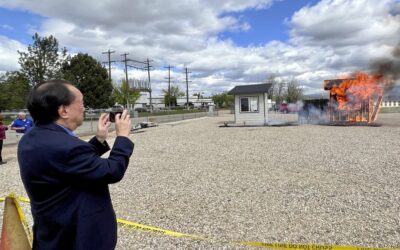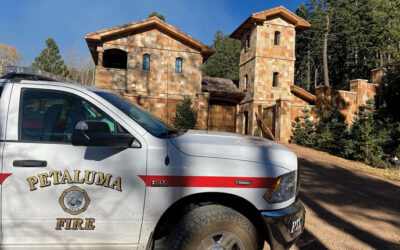Gillian Brassil – McClatchy Washington Bureau
WASHINGTON — Nearly five years ago, Congress told the U.S. Air Force to convert seven surplus Coast Guard aircraft into firefighting tankers for California’s fire protection agency.
It never finished the job. Now, California just wants aircraft. Period.
“We were fortunate this year to have a fire season that wasn’t like we’ve had in previous years,” said Ken Pimlott, now-retired chief of Cal Fire. “But it’s coming back, this is only one year. We can’t afford to lose any more time getting these aircraft retrofitted.”
California Sen. Alex Padilla and Rep. Ken Calvert, R-Corona, put a bipartisan provision in a 2024 defense spending bill to send the C-130 aircraft to Cal Fire immediately — done or not. Still, it’s not guaranteed to make it into the final version of the bill.
“The constant uncertainty and lengthy delays from the Air Force in retrofitting and transferring the seven planes to California have unnecessarily hampered our fire suppression capabilities as we face increasingly frequent and severe fire risks,” Padilla said. He thanked the late Sen. Dianne Feinstein, who helped launch the effort to get the aircraft to California in 2018.
Cal Fire, known as the California Department of Forestry and Fire Prevention, has 65 aircraft, making it the world’s largest civil firefighting fleet. That includes 23 S-2T air tankers, which can hold 1,200 gallons of fire retardant. C-130s — giant four-engine turboprops traditionally used for transport and aerial refueling — can carry up to 4,000.
Fire retardant is used around the fire perimeter slow its spread. Its effectiveness is altered by winds, weather and terrain, but firefighters rely on it to quickly respond to and contain fires, making them easier to fight.
“Strategically-placed retardant where it needs to be in much larger quantities with fewer trips is a huge advantage,” Pimlott said.
Officials say all they need are the planes to add them to their fleet.

An air tanker drops fire retardant south of Highway 46 near Cambria, California in October. The seven surplus Coast Guard aircraft sought by the state would be able to carry more retardant than Cal Fire’s current aircraft. (David Middlecamp/The Tribune/TNS)
“The State of California has worked closely with the Biden Administration, Senator Padilla, the late Senator Feinstein, and Representative Calvert on this proposal to accelerate timelines for getting the aircraft ready and operational for firefighting,” Alex Stack, a spokesman for Gov. Gavin Newsom, said in a statement.
Will the measure for transferring the aircraft pass?
Before Congress can consider whether to keep the provision, in the spending bill, the House of Representatives has to pick a new speaker.
Hardline Republicans and all Democrats ousted former Speaker Kevin McCarthy, R-Bakersfield, after passing a short-term spending agreement to stave off a government shutdown until at least Nov. 17.
Given the ongoing infighting among Republicans, Congress will likely have to pass another short-term plan to keep the government open while they debate the annual spending directives.
If the provision survives budget negotiations and is signed into law with the defense spending bill, Cal Fire expects to get the planes as early as 2024. But, the agency said in a statement, “since that is only proposed language currently, we continue to work directly with our (Department of Homeland Security) and Department of Defense partners on the most expeditious route possible.”
How did California get picked for wildfire aircraft?
The Air Force was charged with updating these aircraft nearly a decade ago. Under a 2014 spending mandate, the surplus Coast Guard planes were supposed to go to the U.S. Forest Service.
Years of delays and new cost estimates led the Trump administration in late 2017 to scrap the idea. In the 2019 defense spending bill, through efforts by Cal Fire under Pimlott and late Sens. Feinstein and John McCain, R-Ariz., Congress directed that the planes go to California, which had a robust firefighting fleet and worsening wildfire seasons.
The Air Force did not respond to a request for comment about the status of the planes’ retrofitting. The Department of Defense declined to comment because the 2024 defense spending bill has not yet passed. Its spokespeople referred The Bee to the Air Force. The Bee reached out to the Coast Guard, which is part of the Department of Homeland Security.
What kept Cal Fire from getting the aircraft?
The first planes were expected to get to California was 2021, Roll Call reported in 2018. But a fresh round of delays — caused by the pandemic and often glacial federal contracting procedures — have prolonged the wait.
“We understand that there have been disruptions to the original schedule for transferring the seven C-130 air tankers to California resulting from the COVID-19 pandemic, questions about the contract, and delays in conducting depot maintenance,” Feinstein and Padilla wrote in a 2021 letter to the then-acting Air Force secretary.
In the letter asking for an expedited transfer, they added, “We are especially concerned with any potential design issues that could prevent the aircraft from obtaining a firefighting capability.”
California wildfires could get worse
Through the defense spending law last year, Padilla and Sen. Kevin Cramer, R-N.D., with help from California lawmakers, were able to lift the cap of seven excess aircraft that the Defense Department could transfer to states and agencies.
Meanwhile, California has seen some of the largest, deadliest and most expensive wildfires in the state’s history. The 2021 Dixie Fire was California’s largest single fire. The 2018 Camp Fire was its deadliest. Rising global temperatures indicate wildfires could become more common and severe.
While this fire season was not as bad as years past, it could get worse going forward. Pimlott hopes that the saga of the seven C-130s comes to a close with this year’s defense spending bill. And that Cal Fire can get them ready fast.
“Hopefully sometime during the year,” Pimlott said, “so that I can see some of them go into service.”
——-
©2023 McClatchy Washington Bureau. Visit at mcclatchydc.com. Distributed by Tribune Content Agency, LLC.




